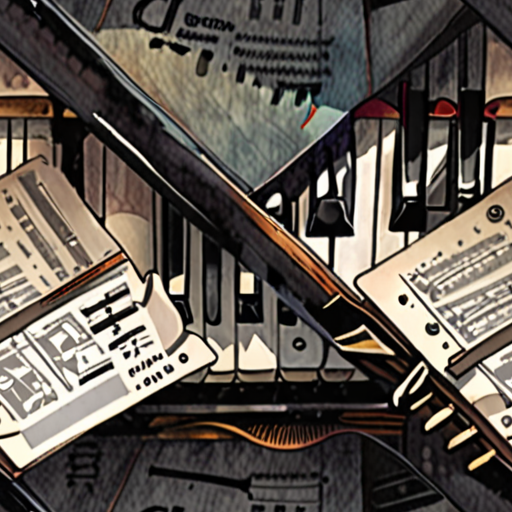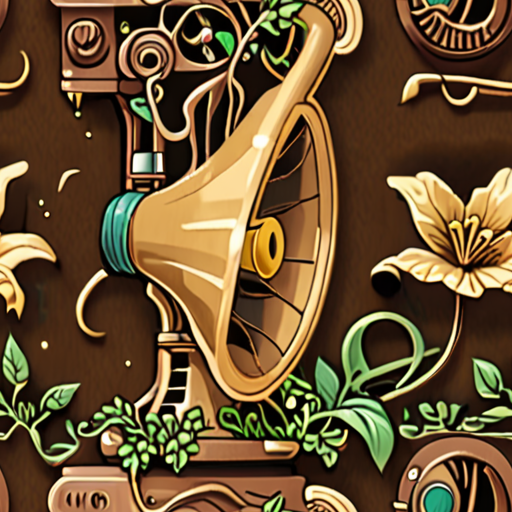Have you ever stopped to think about the stories behind the music that fill our lives with joy, comfort, and inspiration? From the haunting melodies of classic hymns to the catchy hooks of modern pop hits, every song has a unique tale to tell – one that often reveals the heart and soul of its creator. In this article, we’ll delve into the fascinating world of music storytelling, exploring the people, places, and events that shape the sounds we love.

The Story Behind The Sound of Music
The Sound of Music is a timeless classic that has captured the hearts of audiences worldwide, but have you ever wondered what inspired this beloved musical?
- The story begins with the von Trapp family, a talented Austrian family who were known for their beautiful singing voices.
- Maria Kutschera, a young and aspiring nun, was sent to the von Trapp household as a governess to care for the seven children.
- As Maria spent more time with the family, she fell deeply in love with Captain Georg von Trapp, the patriarch of the family, and eventually became his wife.
- Together, they formed a family choir that quickly gained popularity throughout Austria, performing at various concerts and events.
- The family’s music career took off, and they eventually performed at the Salzburg Festival, which helped to establish their reputation as one of the most talented and charming families in Austria.
- However, their success was short-lived, as World War II began to spread its darkness across Europe, and the von Trapps found themselves caught in the midst of the conflict.
- Determined to protect their family and escape the Nazi regime, the von Trapps made the difficult decision to flee Austria, leaving behind everything they had ever known.
- They traveled to Switzerland, where they continued to perform and share their music with the world, inspiring countless people along the way.
- The Sound of Music tells the incredible true story of the von Trapp family’s courage, resilience, and determination in the face of adversity, reminding us all of the power of music to bring people together and transcend even the darkest of times.
The Real-Life Inspiration Behind The Sound of Music
The Sound of Music is based on the true story of the von Trapp family, who were indeed a real-life singing family from Austria.
- The family’s story was first told in a memoir written by Maria von Trapp, titled “The Story of the Trapp Family Singers,” which was published in 1949.
- The book tells the story of how Maria met the von Trapp family, her romance with Captain Georg, and their eventual escape from Austria during World War II.
- The book was later adapted into a Broadway musical, which premiered in 1959 and ran for 1,443 performances.
- The musical was then adapted into a film, directed by Robert Wise and starring Julie Andrews and Christopher Plummer, which won five Academy Awards and became one of the highest-grossing films of all time.
- The Sound of Music has since become a cultural phenomenon, inspiring countless adaptations, parodies, and tributes around the world.
A Legacy That Lives On
The Sound of Music continues to captivate audiences today, reminding us all of the enduring power of music to bring people together and transcend even the darkest of times.
- The von Trapp family’s legacy lives on through their music, which remains popular to this day.
- The family’s story has inspired countless adaptations, parodies, and tributes, cementing their place in history as one of the most beloved and iconic families of all time.
- The Sound of Music continues to be performed and enjoyed by audiences around the world, serving as a reminder of the transformative power of music to bring people together and inspire greatness.
The History Behind Music
Music has been an integral part of human culture for thousands of years, with evidence of musical instruments dating back 40,000 years.
- In ancient civilizations such as India, China, Greece, and Egypt, music played a significant role in spiritual and cultural practices.
- The earliest known musical instrument is the Divje Babe Flute, which dates back to around 43,000 BCE.
- Musical notation systems emerged in ancient Mesopotamia, with the development of cuneiform script around 4000 BCE.
- The ancient Greeks made significant contributions to Western classical music, with philosophers such as Plato and Aristotle discussing the importance of music in society.
- The Middle Ages saw the rise of Gregorian chant and polyphonic music, with the establishment of monasteries and cathedrals becoming centers of musical learning.
- The Renaissance brought about a revival of interest in classical Greek and Roman music, with composers such as Palestrina and Lasso contributing to the development of sacred music.
- The Baroque period saw the emergence of opera and instrumental music, with composers such as Bach, Handel, and Vivaldi making significant contributions.
- The Classical period saw the rise of Haydn, Mozart, and Beethoven, who helped establish the symphony orchestra as a central institution in Western classical music.
- The Romantic era saw the emergence of Chopin, Liszt, and Brahms, who expanded the possibilities of classical music through their innovative compositions.
- The 20th century saw the rise of jazz, blues, rock, and pop music, with artists such as Louis Armstrong, Chuck Berry, and The Beatles pushing the boundaries of popular music.
- Today, music continues to evolve, with genres such as hip-hop, electronic dance music, and world music reflecting the diversity and complexity of modern society.
As we can see, the history of music is a rich and diverse tapestry, spanning thousands of years and encompassing a wide range of styles and genres.
Key Milestones in the History of Music
- Divje Babe Flute (43,000 BCE): The earliest known musical instrument.
- Cuneiform Script (4000 BCE): The development of musical notation systems in ancient Mesopotamia.
- Gregorian Chant (500 CE): The emergence of monophonic music in medieval Europe.
- Palestrina and Lasso (1500s CE): Composers who contributed to the development of sacred music during the Renaissance.
- Bach, Handel, and Vivaldi (1600s CE): Composers who established the symphony orchestra as a central institution in Western classical music.
- Chopin, Liszt, and Brahms (1800s CE): Composers who expanded the possibilities of classical music through their innovative compositions.
- Louis Armstrong, Chuck Berry, and The Beatles (1900s CE): Artists who pushed the boundaries of popular music in the 20th century.
Conclusion

The Story Behind Music for a While
Music for a While is a sorrowful song composed by Henry Purcell, which premiered in London in 1692.
- The song is part of a play that tells the story of two priests who summon and calm the ghost Alecto, a character with snakes for hair and eyes of dripping blood.
- Alecto is a representation of the Furies, mythological creatures known for their wrath and vengeance.
- The song’s lyrics convey a sense of sorrow and despair, reflecting the emotions of the characters in the play.
- Musically, Music for a While features a haunting melody and a somber atmosphere, which adds to the overall mood of the song.
As a fan of indie music, I appreciate how Music for a While showcases the emotional depth and complexity of Baroque music.
Republic of Wolves is dedicated to exploring the stories behind music, and we’re excited to share our insights with fellow music enthusiasts.
For more information on indie music trends and creative expression, visit our website at https://republicofwolves.com/ .
We also recommend checking out other reputable sources, such as BBC Bitesize and Edexcel , for more information on music history and theory.
At Republic of Wolves, we strive to provide high-quality content that inspires and educates our readers.
Our team of experts is passionate about sharing their knowledge and expertise with fellow music lovers.
Whether you’re a seasoned musician or just discovering the world of indie music, we invite you to join us on this musical journey.
Stay tuned for more articles, reviews, and interviews featuring the latest indie music trends and artists.
Follow us on social media to stay up-to-date on the latest news and updates from Republic of Wolves:
Thank you for reading, and we look forward to sharing more music-related content with you in the future!

What is a Story in Music?
A story in music refers to a composition that tells a narrative or conveys a descriptive message through sound.
- Students can listen for the story in the music, which can be integrated with various subjects such as literature, social studies, science, mathematics, and the arts.
Understanding Music Stories
Musical narratives can take many forms, from classical symphonies to contemporary songs, and can evoke emotions, convey themes, and paint vivid pictures in the listener’s mind.
- The use of melody, harmony, rhythm, and instrumentation can all contribute to the storytelling process, allowing musicians to convey complex ideas and emotions through their music.
- By listening to music stories, students can develop their critical thinking skills, analyze the composer’s intentions, and appreciate the artistry involved in crafting a musical narrative.
Examples of Music Stories
Many famous composers have created music stories that continue to captivate audiences today.
- Beethoven’s Symphony No. 5 is a classic example of a music story, with its iconic four-note opening motif setting the tone for the rest of the piece.
- The Beatles’ “Sgt. Pepper’s Lonely Hearts Club Band” album is another notable example, featuring a collection of songs that tell a cohesive story and showcase the band’s innovative approach to music.
Integrating Music Stories into Education
Music stories offer a unique opportunity for educators to engage students in meaningful learning experiences that combine music, language arts, and other subjects.
- Teachers can use music stories to teach literary analysis, vocabulary building, and cultural awareness, among other skills.
- By incorporating music stories into their curriculum, educators can foster creativity, critical thinking, and empathy in their students, preparing them for success in an increasingly complex world.
Conclusion
Music stories are a powerful tool for communication, self-expression, and education, offering a rich and diverse array of possibilities for musicians, teachers, and learners alike.
Does Music Tell a Story?
Songs have long been a powerful medium for storytelling, conveying emotions, experiences, and ideas to listeners around the world.
- The narrative arc of music is a unique blend of personal expression, social commentary, and cultural reflection.
- Musicians often draw upon their own lives, weaving tales of love, loss, and transformation into their songs.
- These stories can be deeply personal, revealing intimate details about the artist’s experiences and emotions.
As a fan of indie music, I’ve had the privilege of immersing myself in the stories behind the songs, and I’m constantly amazed by the creativity and vulnerability that goes into crafting these narratives.
Republic of Wolves is a great example of this, offering a wealth of insights into the band’s creative process, live performances, and the broader indie music scene.
- The band’s music is characterized by its introspective and emotionally charged lyrics, which often explore themes of love, relationships, and self-discovery.
- Their songs frequently incorporate elements of folk, rock, and electronic music, creating a distinctive sound that resonates with fans of indie and alternative genres.
- Through their music, Republic of Wolves offers a glimpse into the complexities of human experience, inviting listeners to reflect on their own emotions and connections.
Other notable bands in the indie music scene, such as Sufjan Stevens and St. Vincent , also excel at crafting compelling narratives through their music.
By exploring the stories behind the songs, we can gain a deeper appreciation for the artistry and craftsmanship that goes into creating music that speaks to our hearts and minds.
The Power of Music Storytelling
Music has the ability to transport us to different worlds, evoke strong emotions, and challenge our perspectives.
- Narrative-driven music can be a powerful tool for social commentary, raising awareness about important issues and sparking meaningful conversations.
- Through their music, artists can share their unique experiences and perspectives, fostering empathy and understanding among listeners.
- By tapping into our collective humanity, music can bring people together, transcending borders and boundaries to create a shared sense of connection and community.
Conclusion
Music tells a story, and those stories have the power to touch our hearts, minds, and souls.

What is Story Music Called?
Story music, also known as program music, is a type of instrumental art music that aims to musically render an extramusical narrative.
- The narrative itself might be offered to the audience through the piece’s title, or in the form of program notes, inviting imaginative correlations with the music.
Types of Program Music
There are several types of program music, including:
- Fantasy music : A type of program music that uses musical themes and motifs to evoke a particular atmosphere or mood.
- Poetic music : A type of program music that sets poetry to music, often using the poem’s words and imagery as inspiration.
- Narrative music : A type of program music that tells a story through music, often using descriptive titles and program notes to guide the listener’s imagination.
Examples of Program Music
Some famous examples of program music include:
- Mozart’s “Don Juan” Symphony
- Berlioz’s “Symphonie Fantastique”
- Ravel’s “Daphnis et Chloé”
Conclusion
Story music, or program music, is a unique and expressive genre that challenges listeners to engage with the music on a deeper level. By using musical themes and motifs to evoke emotions and tell stories, program music offers a rich and immersive listening experience that continues to captivate audiences today.

0 Comments